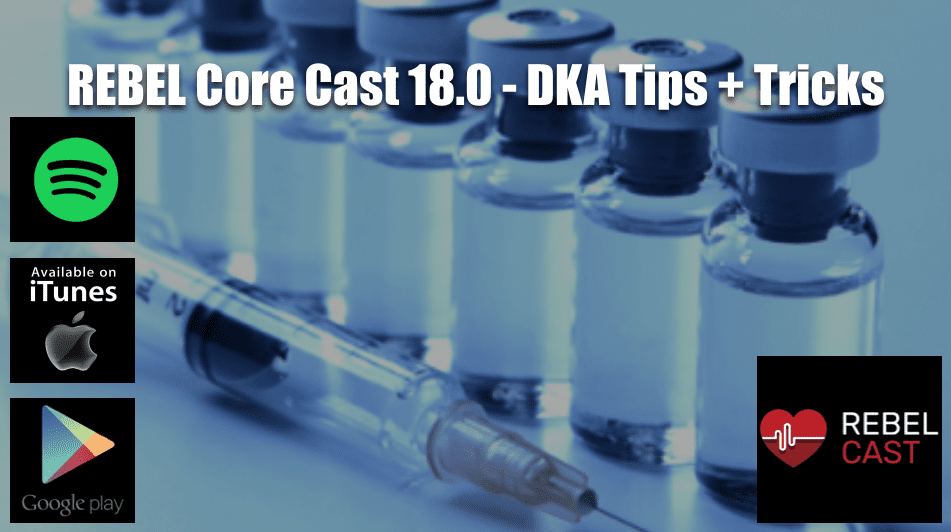
Take Home Points
- When looking at pH and bicarb, the differences between VBG and ABG are miniscule. For DKA patients, stick with the VBG as is less painful and has fewer complications.
- LR is probably a better fluid for the large volume resuscitation required in DKA. Start with a 20 cc/kg bolus and then reassess the patient’s perfusion status.
- Stay on top of your electrolyte repletion. If the patient has a working gut, you can aggressively replete potassium orally and don’t forget that when you are repleting potassium you also must replete magnesium.
- Bolus dose insulin gets the patient to super-physiologic levels and has been associated with higher potassium requirements and more episodes of hypoglycemia. It’s probably fine to skip the bolus and stick with a drip alone
- Don’t forget to think of all possible etiologies of DKA, while we most often find this in patients who have not been taking their home meds for whatever reason, don’t forget a good history to look for sources such as infection and ischemia.
REBEL Core Cast 18.0 – DKA Tips and Tricks
Click here for Direct Download of Podcast
Show Notes
Diagnostic Criteria
- Hyperglycemia
- Acidosis
- Ketosis
Do we need an ABG? Nah
- pH mean difference between abg and vbg was 0.02 pH units. PMID: 21143397
- Bicarb had a difference of -1.41 mmol/L. PMID: 21143397
- pCO2 had a difference of about -6 mmHg
- Not important to know the differences but rather the fact that the differences are irrelevant both in diagnosis and treatment
How much and what kind of fluids?
-
Patients are about 5-10% fluid down which is moderate dehydration
- If hypotensive, more dehydrated and will need more fluid
-
The standard fluid resuscitation is 20-30cc/kg normal saline. Should it be the standard though?
- NS is 154 mEq of Na & Cl with a pH of ~5.7, not ideal for acidotic patient
- NS bolus can lead to non-anion gap hyperchloremic metabolic acidosis stacking on the anion gap acidosis.
-
Reach for a more balanced solution like Lactated Ringers or Plasmalyte
- LR is 130 mEq of NA, 130 Cl, 4 K, 1.5 Ca with a pH of ~6.4
Cerebral Edema
- Volume of fluid will likely not lead to cerebral edema PMID: 29897851
Bicarbonate
- Bicarbonate boluses never shown to be beneficial.
- Isotonic bicarbonate infusion may be helpful. The BICAR-ICU study showed decreased necessity for dialysis in patients treated with isotonic bicarbonate (secondary endpoint)
Electrolyte Derangement
- Total body potassium deficient
- Acidosis causes potassium to shift out of cells and falsely elevated serum levels
- If gut working, give PO (40 mEq) & IV (10-20 mEq)
- If Low K, then assume Low Mg
When to start Insulin
- K above 3.5, start insulin with K infusion
- K less than 3.5, hold insulin and give K
- No bolus dosing, just give infusion (0.1 units /kg) and give their basal insulin
- Don’t forget to look for underlying cause of DKA!!
Resources
- Core EM: DKA
- REBEL EM: DKA Myths
- REBEL EM: Do fluids really matter?
- REBEL EM: Bolus Insulin
- PulmCrit: pH-Guided Fluid Resuscitation and BICAR-ICU
Shownotes Written By: Miguel Reyes, MD (Twitter: @miguel_reyesMD)
Post Peer Reviewed By: Salim R. Rezaie, MD (Twitter: @srrezaie)
The post REBEL Core Cast 18.0 – DKA Tips and Tricks appeared first on REBEL EM - Emergency Medicine Blog.

